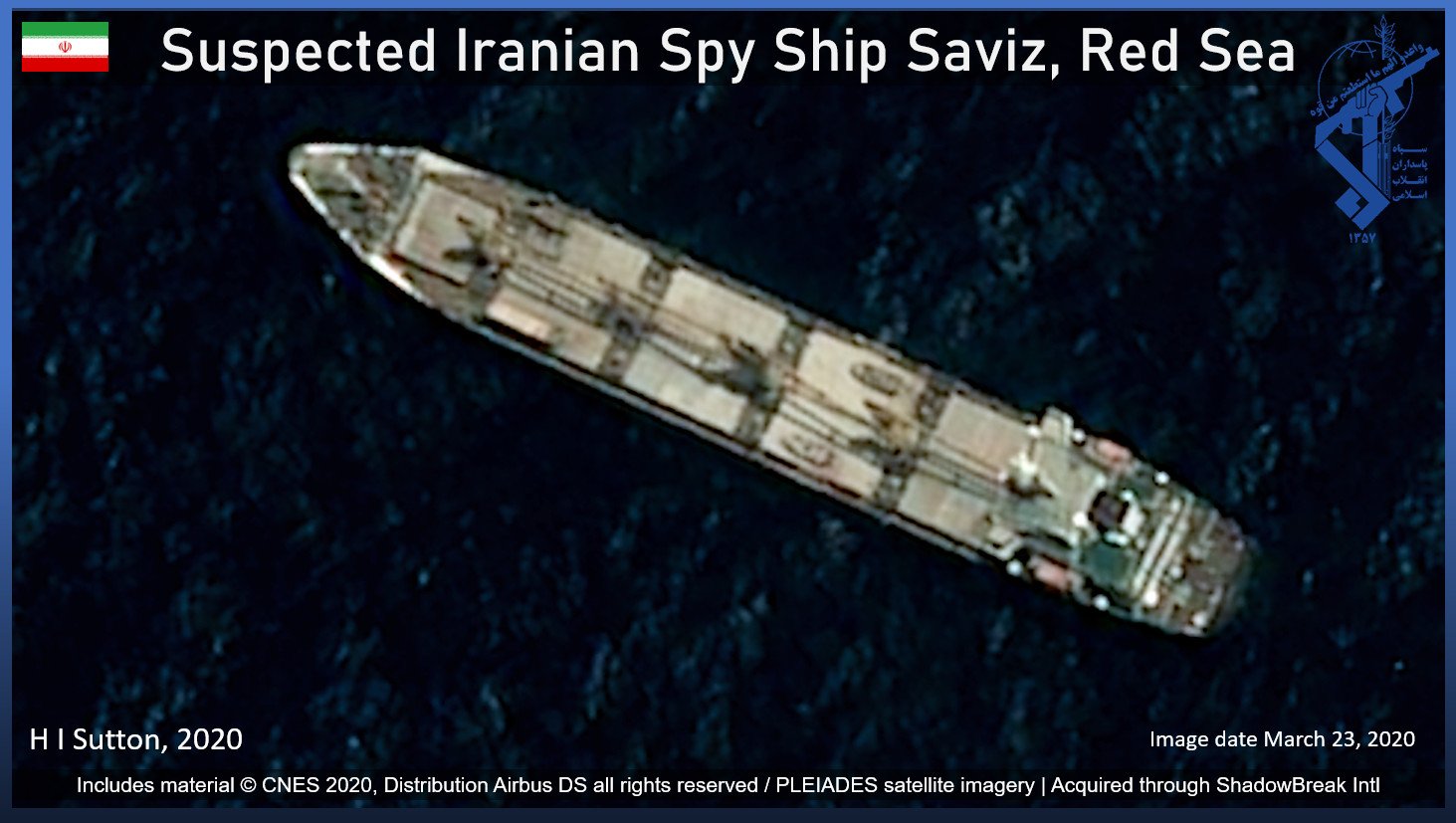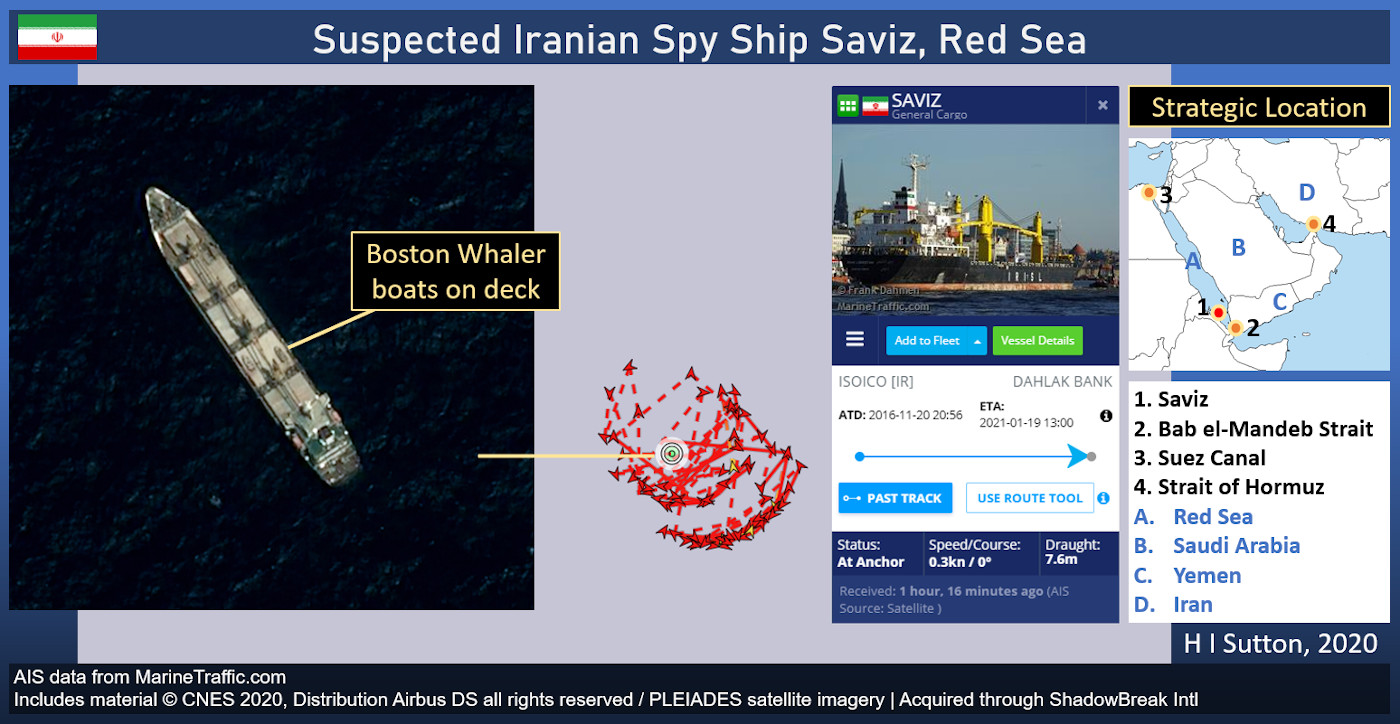
The Red Sea forms a physical and geopolitical choke point on much of the world’s trade. At its northern end the Suez Canal constricts the flow of ships, and at the southern end the Bab el-Mandeb Strait does. Millions of barrels of oil and other critically important goods transit the Red Sea every year, much of it destined for North America and Europe.
It is also a long-standing potential flashpoint. Innocent shipping is exposed to terrorist attacks, covert military action by state actors and the lingering threat of piracy. And watching every vessel that passes is an Iranian ship.
Officially Saviz is a merchant ship, but it is most likely a covert Islamic Revolutionary Guard Corps (IRGC) forward base. Several open-source reports over the last several years and officials with Saudi Arabia have accused the ship of being operated by the IRGC.
The naval role of ships like the Saviz is hard to prove with open sources, but the inference is clear. There is no legitimate civilian explanation for the action, and uniformed men have been seen onboard. On the ship’s deck are Boston Whaler type launches, a boat type popular with the IRGC and not in keeping with Saviz’s civilian design.
The ship is anchored off the Yemen coast at the southern end of the Red Sea, near to where Bab el-Mandeb Strait forms a natural choke point. Automated Information System transmissions and analysis of commercial satellite images show the ship has barely moved in the past three years. From its position, the ship can provide constant surveillance of maritime traffic. The narrow waterway just south of its position squeezes tankers to a channel just a couple of miles wide. There have been numerous attacks on tankers in the area.

Some attacks can be tied to the civil war in Yemen, where Iran is backing and supplying Houthi forces. In 2018, two Saudi tankers were attacked near Bab el-Mandeb, apparently by the Houthis. This caused the oil company, Saudi Aramco, to temporarily halt shipments through the strait. The Saudis may have foiled another attack in March this year. And previously, in October 2016, the Arleigh Burke-class destroyer USS Mason (DDG-87) had to fire Standard Missile -2 and Evolved Sea Sparrow Missiles to intercept missiles fired at it and the afloat forward staging base USS Ponce.
Saviz was in a position to play a role in some of the attacks, feeding intelligence to Iran and its Houthi allies in Yemen, Saudi’s have said. The Houthis are fighting a civil war against Saudi and United Arab Emirates-backed forces. The Houthis have acquired a range of sea mines, anti-ship missiles and remote-controlled explosive boats. Iran’s hand in supplying knowledge, parts and whole systems to the Houthi’s is documented.
The IRGC themselves are also suspected of conducting attacks on tankers in the region. They are accused of placing limpet mines on two tankers in the Gulf of Oman on June 13, 2019. And they have seized tankers for political reasons. In July 2019, they took the British flagged tanker Stena Impero in the Strait of Hormuz, seemingly as retaliation for Britain seizing an Iranian tanker attempting to supply oil to Syria.
Meanwhile, Iranian tankers continue to supply oil to Syria. They sail past the Saviz and up to the Suez Canal, after which they are escorted by Russian warships. Saviz position again may play a role in protecting their tankers as they pass through the Red Sea.
Saviz will likely remain in place for the foreseeable future, hiding behind its civilian identity. From there the ship can provide Iran and its allies with real-time intelligence on every tanker, merchant vessel and warship which passes.





